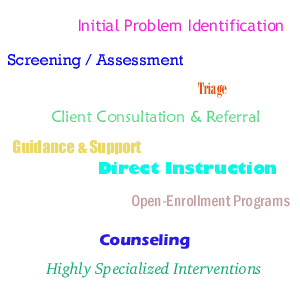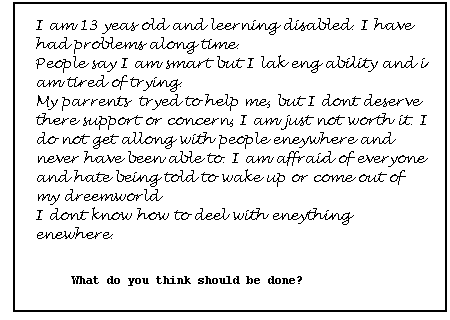REFLECTIONS ON CRISIS COUNSELING
When I first joined the crisis team, I thought we'd usually be dealing with
emergencies that disrupted the whole school. But, most of the emergencies
have involved individual students who seem suicidal or have taken a drug overdose,
and most of the aftermath counseling has involved small groups of students
and staff who are affected by the death of a student or staff member.
In times of crisis, I often have felt overwhelmed by the depth of despair and
grief experienced by so many. In reaching out, I have had to learn how to
draw in those among the quiet ones who will let some of it out only if I encourage
turn-taking during an aftermath group session.
I also have learned how to avoid overwhelming those who are not ready,
psychologically, to deal with what happened and those for whom the event itself
is not important except as a trigger setting off strong emotions (e.g., pent up
grief related to the death of others who were close to them and/or fears
about their own mortality). At the same time, I've learned to avoid playing into
the dynamics of those who just seem to get caught up in and want to maintain
the supercharged atmosphere created by a crisis.
Early in my crisis team experience, I was surprised when one administrator
seemed reluctant to have the team offer aftermath support. He wanted things
to return to 'normal' as fast as possible and was convinced the team's activity
would keep things stirred up. He also expressed concern that many students would be
overwhelmed by the added pressures of reflecting on what had happened, listening
to others' reactions, and expressing their own. He had concluded that the
best strategy was to encourage everyone to put the event behind them and get on
with things. We agreed that he was probably right with respect to most students.
And, we finally convinced him that we could proceed in ways that would help
to normalize the situation for the majority and still provide for those with special
needs.
I have since learned that many people share a concern that crisis interveners
don't appreciate how many individuals are ready to get on with things. So, I
always try to assure everyone that I understand this, and then I clarify that
helping those with special needs is an important part of getting things back
to normal.
A specific aspect of normalization after the death of a student or staff member
seems to be a wide-spread desire to gather funds to help the family if there
is a need and/or to arrange a tribute. When this is the case, the concerned energy
of most of the school population can be channeled in this direction after initial
expressions of emotion are validated. Extended aftermath groups are necessary
only for those seen as profoundly affected.
One of the hardest things about crisis counseling is establishing a
relationship with students who don't know me at a time when they desperately need
someone familiar whom they can trust. Therefore, I try, whenever possible, to
enlist someone to work beside me who the students look up to. At the very
least, I quickly identify someone in the group with whom I can ally myself.
Responding to crisis is exhausting. Thus, we have found it essential to have
enough team members to spell each other whenever extended counseling is
required on a given day. In responding to the needs of others, it is easy to ignore
the impact on ourselves.
As a health professional, what drew me to crisis intervention is that I knew
it was an essential element of any comprehensive approach to maintaining
psychological well-being. What I didn't realize was what a powerful contribution
an active school-based crisis team could make to a school's sense of community. At
first, team meetings focused on improving crisis response plans and
communicating them to the rest of the school. We found our efforts to take care
of these matters were reassuring to others. Once these tasks were accomplished, we
found ourselves addressing other school safety concerns and ways for
students and staff to be more supportive of each other. In many ways, the crisis
team has become a special forum for sharing concerns and a symbol of the school
community's commitment to taking care of each other. And, I think that is
pretty basic to maintaining our mental health! |

![]() explain the immediate objective of psychological first aid.
explain the immediate objective of psychological first aid.![]() identify three phases of crisis intervention
identify three phases of crisis intervention![]() identify seven activities related to providing psychosocial
guidance and support
identify seven activities related to providing psychosocial
guidance and support ![]() identify at least 5 specific things that can be done to
facilitate student communication in a psychosocial counseling situation
identify at least 5 specific things that can be done to
facilitate student communication in a psychosocial counseling situation



